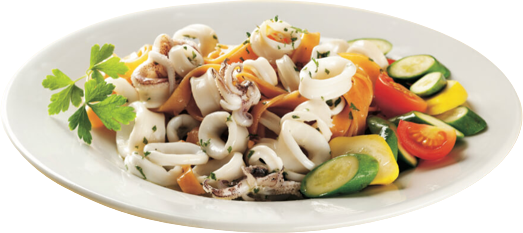

Calamari
Squid are bizarre life forms that have fired our imaginations for centuries. There’s Scylla in the Odyssey, the Kraken in Tennyson’s poem of the same name and “the great live squid” in Moby Dick. Modern impressions of the squid began to form with Jules Verne’s “20,000 Leagues Under the Sea,” which was published in Paris in 1871. Drawing on reports of real-life encounters, Verne depicted the giant squid fairly accurately with its primate-like stereoscopic eyes, a large head and writhing tentacles. Although unattractive, squid, or Calamari as it’s known in Italy, has found its way to mainstream America, from fish-n-chip stands to white tablecloth restaurants.
Squid are soft-bodied cephalopods, related to other mollusks such as octopus, cuttlefish, clams and oyster. These deep-sea creatures have two hearts and brains large enough to suggest they are among the smartest creatures on the earth. They move by squirting water from their heads, called mantles, through a siphon, called a hyponome, which shoots them away from their predators or moves them along quickly. Squid can change color like a chameleon to mimic their environment and hide from predators, as well as squirt a cloud of dark ink to confuse their attacker and allow the squid to escape.
Cephalopods are famous for the gangly limbs encircling their mouths. Octopuses, squid, and cuttlefish possess cone-shaped limbs studded with rows of suckers and referred to as arms. In addition, squid and cuttlefish brandish a pair of tentacles. They are aggressive predators, seizing their prey with two lightning-fast, hook-laden tentacles, drawing the prey into a squirming nest of eight arms and tearing chunks of flesh from its body with its disproportionately large, razor-sharp, parrot-like beak.
Cephalopods usually have three hearts. Two hearts pump blood to the gills, and one central heart pumps oxygenated blood to the body. Cephalopod blood is blue because it binds oxygen using a blue, copper-containing protein called hemocyanin. Human blood is red because the oxygen-binding protein hemoglobin contains iron.
Most cephalopods are endowed with a small ink-producing gland within an ink sac, embedded in their digestive systems. When threatened by predators, the sac expels highly concentrated melanin to obscure the animal from predators.
The squid ranges from one inch in size up to eighty feet, but the most common size for eating is less than twelve inches.
Appearance/Flavor
Called Calamari in Italy, Squid meat is chewy, yet firm and white with a mild, slightly sweet and almost nutty flavor. Quality squid is easy to tell. It smells like the ocean, never strong or fishy. It looks shiny and firm, not saggy and deflated. The membrane covering the squid is gray, not purple or pink.
Cooking Methods
Squid lends itself to just about every cooking method imaginable and is often eaten raw in sushi dishes.
Deep frying
Pour oil into a wok or deep fryer; it should be at least 1 1/2 inches (about 3.8cm) deep, and the cooker should be less than half full of oil. Heat oil to 375’F (190’C), using a thermometer to monitor temperature. Dip squid in batter, drain, and then slip pieces into hot oil. Cook until crisp (about 45 seconds). Don’t wait until it turns brown or it will be overcooked.
Pan frying
Dip tenderized squid in a beaten egg’milk mixture, then in crumbs and spices if desired. Heat a frying pan until hot and add oil. Add squid, making sure they are not crowded in the pan, and cook, turning once, until brown, about 2 minutes.
Stir-frying
Stir-fry squid gently in hot oil for about 30 seconds before adding to your favorite stir-fried vegetables. Total cooking time should not exceed 2 minutes.
Grilling
Put squid on skewers to keep from curling, and then place them 1 inch (2.5cm) above prepared hot coals or fire. Cook for 2 minutes on each side.
Braising
Braise squid in cooking liquid and herbs and spices for about 1 hour.
Nutrition/Health
Like meat, fish and poultry, squid provides high-quality proteins with sufficient amounts of all the essential amino acids, as well as phosphorus and traces of calcium, thiamine and riboflavin. Squid has less saturated fat than meat and small amounts of omega-3 fatty acids, a group that includes the essential fatty acid linolenic acid, plus ecosapentaenoic acid (EPA) and dicosahexanoic acid (DHA), the primary unsaturated fatty acids in oils from fish.
However, like shellfish, squid and octopus may be a significant source of cholesterol. The cholesterol content of squid can vary from animal to animal. There is no reliable guide to choosing the one that is lower in cholesterol. As a general rule, the mantle (body) generally has less cholesterol than the tentacles.
Four ounces raw squid has 1.58 g fat (0.38 g saturated fat), 266 mg cholesterol, and 17.8 g protein. Four ounces of raw octopus has 1 g fat (0.3 g saturated fat) and 54 mg cholesterol, and 17 g protein. The most nutritious way to serve this food is to prepare with little or no added fat, so as to preserve the seafood’s status as a low-fat food. People who are on low-cholesterol, low-protein and low-sodium diet should avoid this food.
